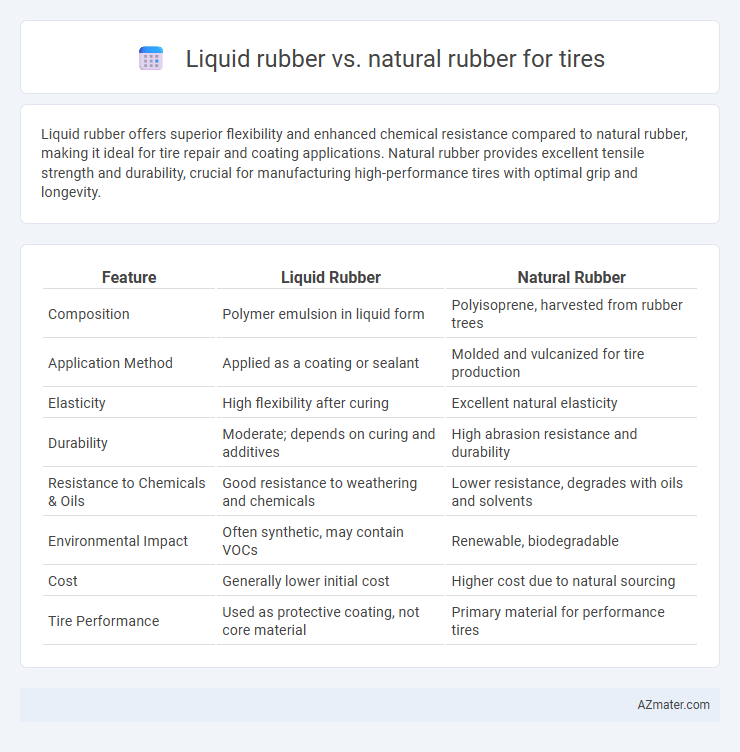Liquid rubber offers superior flexibility and enhanced chemical resistance compared to natural rubber, making it ideal for tire repair and coating applications. Natural rubber provides excellent tensile strength and durability, crucial for manufacturing high-performance tires with optimal grip and longevity.
Table of Comparison
| Feature | Liquid Rubber | Natural Rubber |
|---|---|---|
| Composition | Polymer emulsion in liquid form | Polyisoprene, harvested from rubber trees |
| Application Method | Applied as a coating or sealant | Molded and vulcanized for tire production |
| Elasticity | High flexibility after curing | Excellent natural elasticity |
| Durability | Moderate; depends on curing and additives | High abrasion resistance and durability |
| Resistance to Chemicals & Oils | Good resistance to weathering and chemicals | Lower resistance, degrades with oils and solvents |
| Environmental Impact | Often synthetic, may contain VOCs | Renewable, biodegradable |
| Cost | Generally lower initial cost | Higher cost due to natural sourcing |
| Tire Performance | Used as protective coating, not core material | Primary material for performance tires |
Introduction: Liquid Rubber vs Natural Rubber in Tire Manufacturing
Liquid rubber offers enhanced flexibility and superior chemical resistance, making it a valuable material in tire manufacturing where durability and performance under various conditions are critical. Natural rubber, derived from latex, provides exceptional elasticity, resilience, and wear resistance, contributing to the structural integrity and comfort of tires. Comparing liquid rubber and natural rubber highlights differences in processing methods, mechanical properties, and environmental impact, influencing tire design and functionality.
Key Material Properties: Liquid Rubber vs Natural Rubber
Liquid rubber exhibits superior flexibility and elongation at break compared to natural rubber, enhancing impact resistance and durability in tire applications. Natural rubber offers excellent tensile strength and resilience but is more prone to degradation under UV exposure and ozone, affecting tire longevity. The enhanced chemical resistance and lower permeability of liquid rubber improve tire performance in harsh environments, making it a viable alternative for specialized tire compounds.
Durability and Wear Resistance Comparison
Liquid rubber offers enhanced durability and superior wear resistance compared to natural rubber in tire applications due to its excellent flexibility and strong adhesive properties. Natural rubber provides good elasticity but tends to degrade faster under harsh conditions, such as heat and UV exposure, leading to quicker wear. Tires made with liquid rubber compounds exhibit longer service life and improved resistance to abrasion, making them a preferred choice for high-performance and heavy-duty uses.
Performance in Extreme Weather Conditions
Liquid rubber exhibits superior flexibility and durability in extreme weather conditions, maintaining elasticity in freezing temperatures and resisting cracking under intense heat, which enhances tire longevity. Natural rubber, while offering excellent grip and resilience, tends to harden in cold climates and soften in extreme heat, potentially compromising tire performance and safety. The enhanced weather resistance of liquid rubber formulations makes them a preferred choice for tires designed to withstand fluctuating and harsh environmental conditions.
Manufacturing Process Differences
Liquid rubber, often used in tire manufacturing, undergoes a curing process involving chemical cross-linking at lower temperatures compared to the traditional vulcanization of natural rubber, which requires higher heat and longer curing times. Natural rubber is harvested from Hevea brasiliensis trees and shaped through mechanical processing before vulcanization, while liquid rubber is synthesized and applied in a more controlled, uniform manner that enhances flexibility and adhesion. The manufacturing process using liquid rubber allows for precise formulation adjustments and quicker production cycles, improving efficiency and performance consistency in tire production.
Cost Analysis: Liquid Rubber vs Natural Rubber
Liquid rubber offers a cost-effective alternative to natural rubber in tire manufacturing due to lower raw material prices and reduced processing expenses, making it suitable for budget-sensitive applications. Natural rubber, while typically more expensive, provides superior elasticity and durability, which can justify its higher cost in high-performance or heavy-duty tires. Overall, the choice between liquid rubber and natural rubber hinges on balancing material costs with performance requirements and lifecycle value.
Environmental Impact and Sustainability
Liquid rubber, derived from synthetic polymers, offers enhanced durability and chemical resistance, reducing tire wear and extending lifespan, which contributes to lower environmental impact through reduced raw material consumption and waste. Natural rubber, sourced from rubber trees, is renewable and biodegradable, supporting carbon sequestration and promoting sustainable farming practices, though its production can lead to deforestation and habitat loss if not managed responsibly. Balancing these factors, liquid rubber provides longer use phases, while natural rubber emphasizes biodegradability and renewable sourcing, making tire manufacturers consider hybrid blends to optimize sustainability.
Application Suitability for Various Vehicle Types
Liquid rubber offers superior flexibility and corrosion resistance, making it ideal for customizing tires of off-road and heavy-duty vehicles that encounter harsh terrains. Natural rubber provides excellent elasticity and traction, preferred in passenger cars and motorcycles for smooth highway driving and fuel efficiency. Each material's performance characteristics influence tire durability and ride comfort based on specific vehicle type requirements.
Market Trends and Industry Adoption
Liquid rubber is gaining traction in the tire industry due to its superior flexibility, durability, and ease of application compared to natural rubber. Market trends indicate a rising preference for liquid rubber formulations driven by increased demand for sustainable, high-performance tires that improve fuel efficiency and reduce wear. Major tire manufacturers are adopting liquid rubber technologies to enhance product longevity and meet stringent environmental regulations.
Future Innovations in Tire Rubber Technology
Future innovations in tire rubber technology are increasingly exploring liquid rubber formulations due to their enhanced adaptability and self-healing properties compared to traditional natural rubber. Liquid rubber can improve tire performance by offering superior elasticity, wear resistance, and the ability to repair micro-cracks autonomously, extending tire lifespan significantly. Research focuses on integrating nanomaterials and smart polymers into liquid rubber composites, aiming to create more sustainable, high-performance tires that respond dynamically to varying road conditions and environmental stresses.

Infographic: Liquid rubber vs Natural rubber for Tire
 azmater.com
azmater.com